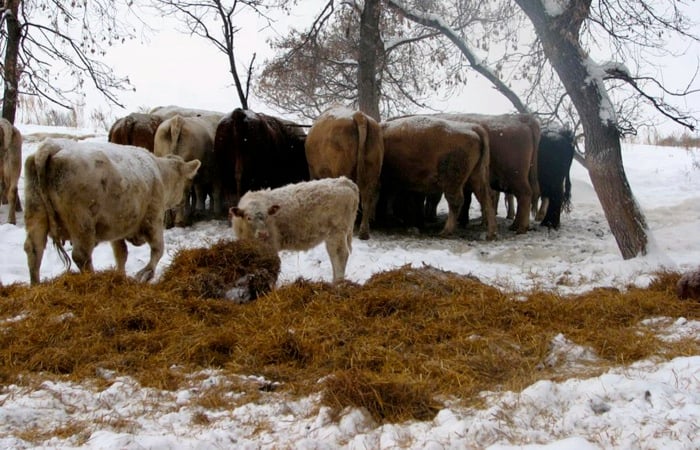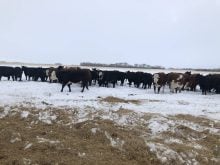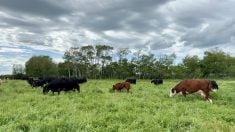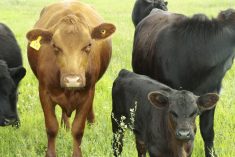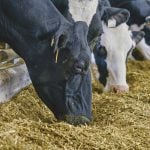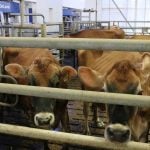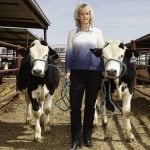As I write this most of the country is in a deep freeze with no end in sight. We all know how hard the cold is on equipment, machinery and people, however, we sometimes forget that our cows are also susceptible to severe environmental conditions. Fortunately, beef cows are hardy animals that can adapt to extreme conditions. However, in order for them to do so three conditions must be met. First and most importantly they need to have access to feed that meets their nutritional requirements for maintenance functions as well as that for pregnancy and perhaps lactation. Secondly, they need shelter from the wind, either natural or man made and thirdly they need to be kept dry, either through bedding of pens or an appropriate wintering area.
Read Also

What to know before you go to Agribition 2025
If you’re attending Agribition 2025, this is the place to find out about tickets, dates and what’s happening this year.
Cold weather impacts the maintenance energy requirements of cattle. Maintenance energy is the proportion of dietary energy that is used to keep cattle alive (i.e. not for pregnancy or milk production but to keep them alive). Typically the maintenance energy requirement of a beef cow is fairly constant within certain environmental temperatures. These are known as the upper and lower critical temperatures. The lower critical temperature is that temperature below which the cow must increase metabolic activity (i.e. heat production) in order to maintain core body temperature. The increase in metabolic activity increases the maintenance energy needs of the animal. The colder the temperature, the greater the exposure to wet, windy conditions, the greater the increase in maintenance energy requirements.
This increase in maintenance energy requirement has several important consequences. First, it increases your feed costs as you need to adjust your feeding program to account for the extra energy required to combat the cold. More importantly, failure to provide this extra energy will result in weight loss, as your cows will use stored fat to keep warm. In situations where your cows went into winter in good body condition, losing some weight during periods of cold stress is not that critical as long as the weight loss is not excessive. However, when cows are in poor to marginal condition to start, such weight loss can have very negative effects, not just on the comfort of the cow and viability of her calf, but also on her subsequent breeding performance.
The question often asked is what is the lower critical temperature at which we see an increase in energy requirements? While there is no set answer to this question, remember that cows like people, become acclimatized to winter. They do this in a variety of ways including coming off fall grass in the fall in good body condition, growing a winter hair coat and through an increased metabolic rate. It is my experience that cows adapted to winter in such a fashion that are kept dry and out of the wind acclimatize very readily to winter temperatures as low as -15 to -20 C. An important caveat to this statement is that in addition to environmental protection, a feeding program that meets nutritional needs for both maintenance and pregnancy must be provided. In such cases, most cows will winter without losing condition and should have minimal issues calving. Further, proper attention to post-calving nutritional needs will help to achieve a tight successful breeding season.
However, once the temperature drops below this range, we need to take proactive steps to meet the increased maintenance energy requirements and to prevent excessive weight loss. There are a number of approaches that can be used. Feed intake for example generally increases in cold weather. Providing access to more feed or in cases where cows are being wintered on a low-quality forage, switching to a higher-quality forage will provide more digestible energy. However, in many cases, cows particularly those on extensive wintering programs (bale grazing/swath grazing) have access to full feed, so supplying more of the same forage is not always an option. In such cases providing additional grain or another concentrated energy supplement (i.e. fortified grain screening pellets, dry distillers grains) is likely the easiest method of supplying additional energy during periods of cold stress. One rule of thumb often cited is to provide one pound of additional grain per head per day for every 5° the temperature drops below -20 C. For cows exposed to temperatures of -30 C to -35 C, this means providing an additional three to four pounds of barely (or its equivalent) per head per day.
Another area where cows can run into issues with cold weather is with abomasal impaction. As stated above, during periods of extreme cold cows will increase feed intake. When fed low-quality forage-based diets (i.e. straw), dietary energy and protein content can limit rumen fermentation activity. The result is a reduction in digestibility, a reduced passage rate and eventually the rumen and abomasum (true stomach) can become “plugged.” To prevent this condition, you can feed a higher-quality forage or provide supplemental grain to ensure an active rumen.
A final word of caution — when supplementing with relatively high levels (eight to 10 pounds or more) of grain there is a potential for rumen acidosis to occur so it is wise to supplement twice a day.
John McKinnon is a beef cattle nutritionist at the University of Saskatchewan


